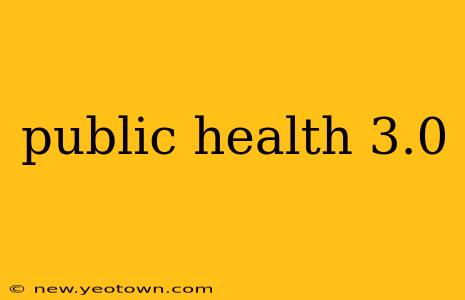The landscape of public health is undergoing a seismic shift. We've moved beyond the reactive measures of the past, transitioning from a focus on infectious disease control to a more proactive, data-driven, and personalized approach. This evolution, what some call "Public Health 3.0," isn't just an incremental improvement—it's a fundamental paradigm change, prioritizing prevention, leveraging technology, and empowering individuals to take control of their well-being. Let's delve into this exciting new era.
What Characterizes Public Health 3.0?
Imagine a world where health isn't just treated when it's broken, but actively nurtured and protected. That's the promise of Public Health 3.0. This new era is defined by several key characteristics:
-
Proactive and Preventative: Instead of solely responding to outbreaks and crises, Public Health 3.0 emphasizes prevention through initiatives like promoting healthy lifestyles, early detection programs, and addressing social determinants of health. It's about building resilience before illness strikes.
-
Data-Driven Decision Making: We're drowning in data, and Public Health 3.0 harnesses its power. Real-time data analysis helps identify emerging threats, track disease spread, and tailor interventions to specific populations and communities.
-
Personalized and Precision Public Health: One-size-fits-all approaches are becoming obsolete. Public Health 3.0 recognizes individual differences in genetics, lifestyle, and environment, allowing for customized interventions and preventative strategies.
-
Technology Integration: From wearable health trackers to sophisticated epidemiological modeling, technology plays a central role. This allows for improved surveillance, communication, and the delivery of health services.
-
Community Engagement and Empowerment: Public Health 3.0 isn't solely about top-down initiatives. It fosters collaboration with communities, empowering individuals to participate in their own health and the health of their surroundings.
How Does Public Health 3.0 Differ from Previous Eras?
Public health has evolved through distinct phases. Public Health 1.0 focused primarily on sanitation and infectious disease control, reacting to outbreaks like cholera and typhoid. Public Health 2.0 expanded this scope to include chronic diseases and risk factors, introducing health promotion campaigns and population-level interventions. Public Health 3.0 builds upon these foundations, adding a layer of personalization, data analysis, and technological integration that fundamentally transforms how we approach wellness.
What are the Key Challenges of Public Health 3.0?
Implementing Public Health 3.0 isn't without its hurdles:
-
Data Privacy and Security: The increased reliance on data raises serious concerns about individual privacy and the security of sensitive health information. Robust data governance and ethical frameworks are crucial.
-
Equity and Access: Technological advancements must ensure equitable access to services and resources, bridging the digital divide and addressing health disparities in underserved communities.
-
Interoperability and Data Sharing: Different health systems and databases need to communicate effectively, which requires standardized data formats and interoperable systems.
How Can Technology Enhance Public Health 3.0?
Technology is a cornerstone of Public Health 3.0. Here are some examples:
-
Wearable Sensors and Mobile Health Apps: These tools provide real-time data on individual health metrics, enabling early detection of potential problems and personalized interventions.
-
Artificial Intelligence and Machine Learning: AI can analyze large datasets to identify patterns, predict outbreaks, and personalize health recommendations.
-
Big Data Analytics: Analyzing vast amounts of data from various sources can reveal hidden trends and inform public health policies.
What is the Future of Public Health 3.0?
The future of Public Health 3.0 is bright, but it requires continued innovation, collaboration, and a commitment to addressing the challenges discussed above. As technology advances and our understanding of health deepens, we can expect even more personalized, proactive, and effective approaches to wellness. The goal is not merely to treat illness, but to build a healthier world, one individual, one community, at a time. This is a journey, and we are just at the beginning of a new and exciting chapter in public health.

